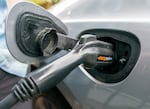Oregon’s electric vehicle sales have skyrocketed, nearly doubling in the past two years. Despite the increase in sales, a state agency report released this month says more work is needed to meet the state’s greenhouse gas emissions reduction goals.
The Oregon Department of Energy’s Biennial Zero Emission Vehicle Report says there are nearly 70,000 registered EVS in the state as of April. That’s almost double the amount registered in 2021. Oregon is also second nationwide, behind California, for all new vehicles sold in the state registered as EVs.

The Musser family’s hybrid vehicle, being charged at the home charging station, Dec. 1, 2022. The single-family home has been retrofitted to reduce the family’s carbon footprint, and is equipped with solar panels, hybrid heat pump hot water heater, high-efficiency appliances and lighting, an electric vehicle charging station and a whole-home battery storage system.
Kristyna Wentz-Graff / OPB
The report, which was initiated during the 2019 Oregon Legislature under Senate Bill 1044, requires the state Department of Energy to outline and assess how electric vehicles are reducing the state’s transportation sector’s greenhouse gas emissions, and what opportunities are available to increase adoption.
According to the Department of Environmental Quality, the transportation sector accounts for 35% of the state’s total greenhouse gas emissions.
“In the span of two years, we’ve doubled our EVs in the state and that’s a big deal,” said Jessica Reichers, the Energy Department’s technology and policy manager. “We’re selling a lot of cars.”
Reichers said some of the progress is attributed to federal and state rebates for purchasing new or used EVs and Oregon adopting rules that end the sale of gas-powered vehicles by 2035.
Oregon has made gains in EV adoption because of substantial purchase rebates, up to $15,000 in some cases, that has led to a push to make charging stations more publicly available.
But while EV sales are up, the report says those sales on their own aren’t enough to meet the state’s overall carbon reduction goals by 2050. A report earlier this year found the state fell short in meeting its 2020 climate benchmarks by 13% and will also miss its 2021 goal by 19%. The state will also fall short of reaching a goal of 250,000 registered EVs by 2025, but expects to meet other EV goals by 2030.
Reichers said despite not meeting those goals, EVs are becoming more popular.
“The more people have experience with and see EVs in their communities,” she said, “the more likely they are to pick an EV as their next car.”
Reichers said data still show that Oregonians with higher incomes are adopting EVs much faster. One of the reasons could be affordability, she said. For low-income residents, barriers like affordability are limiting access to these vehicles.
The Oregon Department of Environmental Quality has rebate programs to help lower-income Oregonians purchase electric vehicles. But the program ran out of money in May, causing the program to pause for the first time since implementation. Residents who purchased an EV on or before April 30, have six months to apply for the rebate. They will be placed on a waitlist and receive the rebates once the program is replenished in March. According to DEQ, there are currently 1,787 people on the waitlist.
There is no indication of whether the state will increase the money available for rebates to avoid another suspension.
Other barriers Oregonians face when considering the switch are battery reliability and charging infrastructure, Reichers said.
She said the agency found people felt the current charging infrastructure was unreliable, which could make people less likely to switch, especially if they are renters or people who live in multi-unit housing who may not have a garage or space to charge their car.
“Getting that public infrastructure in place that is close by and where they can access it and that it’s reliable… that’s a critical piece I think in someone making a decision,” she said.

The Musser family’s hybrid vehicle, being charged at the home charging station, Dec. 1, 2022. The single-family home has been retrofitted to reduce the family’s carbon footprint, and is equipped with solar panels, hybrid heat pump hot water heater, high-efficiency appliances and lighting, an electric vehicle charging station and a whole-home battery storage system.
Kristyna Wentz-Graff / OPB
Last year, the Oregon Department of Transportation committed to investing $100 million over the next five years in increasing EV fast charging stations across several major corridors throughout the state. The agency is currently finalizing approved vendors to begin installing chargers by next spring. In its first year, the plan is to focus on enabling long-distance travel by installing chargers in rural and underserved areas, as well as heavy traffic corridors like the southern portion of Interstate 5, Interstate 205 in Portland and Highway 97 in Central Oregon. There are currently more than 2,700 public EV charging stations throughout the state.
The state also needs chargers for medium and heavy-duty electric trucks to help make the switch. Adoption of these vehicles has been slow due to their high costs and a lack of infrastructure.
If the state can keep rebate programs going and build out its charging infrastructure, Reichers said the state will meet its 2035 EV goals.
“It requires a little bit of work on our part to make sure the charging infrastructure is there and to make sure that we implement these programs that we put in place,” she said. “But it’s achievable.”
